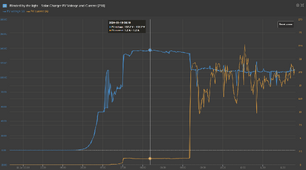I have bought some Victron items (shunt, small mppt) and I really love them, except I don't see how I can log their details.
I have thought about putting together an all Victron system, but I find the Inverters disappointing. They don't balance with their other components.
For Instance, a fairly low end mppt is the 150/30 which theoretically puts out 150V * 30 amps = 4500 Watts, but I'll expect half of that, or 2250 volts.
If I match this up with a fairly high end inverter, the Victron Phoenix Inverter 48/1200 | 1200VA Output| 48VDC Input | 120VAC Output
The manual says at 40C the continuous output is 900Watts, not enough to power a single 15A 120VAC outlet.
I see a lot of systems with 4 or more Victron mppts. I guess they aren't using Victron inverters for these, or they are using many of them which doesn't seem practical.
Can anyone recommend an inverter with a decent sine wave and enough power to support a couple of 15A 120VAC outlets? I have a cheap inverter to play with, but it looks like a staircase on an oscilloscope.
Thanks
I have thought about putting together an all Victron system, but I find the Inverters disappointing. They don't balance with their other components.
For Instance, a fairly low end mppt is the 150/30 which theoretically puts out 150V * 30 amps = 4500 Watts, but I'll expect half of that, or 2250 volts.
If I match this up with a fairly high end inverter, the Victron Phoenix Inverter 48/1200 | 1200VA Output| 48VDC Input | 120VAC Output
The manual says at 40C the continuous output is 900Watts, not enough to power a single 15A 120VAC outlet.
I see a lot of systems with 4 or more Victron mppts. I guess they aren't using Victron inverters for these, or they are using many of them which doesn't seem practical.
Can anyone recommend an inverter with a decent sine wave and enough power to support a couple of 15A 120VAC outlets? I have a cheap inverter to play with, but it looks like a staircase on an oscilloscope.
Thanks





